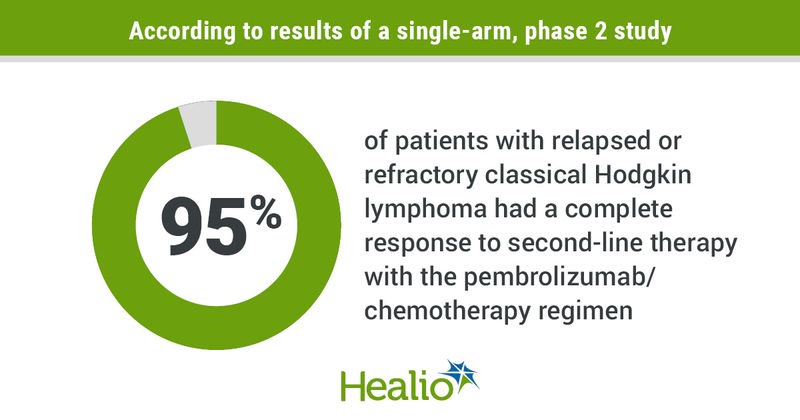Pembrolizumab regimen safe, effective in relapsed or refractory Hodgkin lymphoma
Pembrolizumab plus gemcitabine, vinorelbine and liposomal doxorubicin demonstrated substantial efficacy as second-line therapy among patients with relapsed or refractory classical Hodgkin lymphoma, according to phase 2 study results.
The findings, published in Journal of Clinical Oncology, also showed the combination had a favorable toxicity profile.

“Our study is unique in that it is in the outpatient setting and we combined chemotherapy with a checkpoint inhibitor in a curative patient population,” Craig H. Moskowitz, MD, physician-in-chief of the oncology service line at Sylvester Comprehensive Cancer Center at University of Miami Miller School of Medicine and a HemOnc Today Editorial Board member, told Healio. “Unexpectedly, these results are better than any other reported in the literature, with nearly 95% of the patient population having achieved a complete response to therapy, and all 38 patients are currently in remission after stem cell transplant.”

The single-arm, multicenter study enrolled 39 transplant-eligible patients (median age, 38 years; range, 21-71; 54% women; 74% white) with relapsed or refractory Hodgkin lymphoma. Overall, 41% of patients had primary refractory disease and 38% relapsed within 1 year of first-line therapy.
Study participants received the PD-1 inhibitor pembrolizumab (Keytruda, Merck) dosed at 200 mg on day 1, plus 1,000 mg/m² gemcitabine, 20 mg/m² vinorelbine and 15 mg/m² liposomal doxorubicin on days 1 and 8 of two to four 21-day cycles.
Complete response served as the primary endpoint.
Results among 38 evaluable patients showed an overall response rate of 100% (95% CI, 91-100) and a complete response rate of 95% (95% CI, 82-99).
Most patients (95%) went on to receive high-dose therapy and autologous hematopoietic stem cell transplant. Two patients received pre-high-dose therapy and autologous HSCT-involved site radiation and 13 received high-dose therapy and autologous HSCT plus brentuximab vedotin (Adcetris, Seagen) maintenance therapy.
At median follow-up of 13.5 months, all 36 transplant-eligible patients remained in remission.
Grade 3 adverse events included transaminitis (n = 4), neutropenia (n = 4), mucositis (n = 2), thyroiditis (n = 1) and rash (n= 1).
“Based upon these results we are treating another group of patients but excluding transplantation with the hope that this simple treatment can cure patients with relapsed Hodgkin lymphoma without receiving high-dose chemoradiotherapy and autologous [HSCT] that requires a 3-week hospitalization with both short-term and long-term side effects,” Moskowitz told Healio.
For more information:
Craig H. Moskowitz, MD, can be reached at Sylvester Cancer Center, 1475 NW 12th Ave., 1st Floor, Miami, FL 33136; email: chm78@miami.edu.

